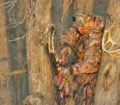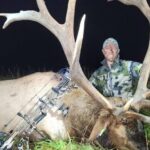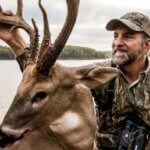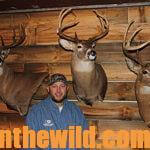Editor’s Note: Michael Braden (http://michaelbradenarchery.com/) of Houston, Texas, has won both ASA 3-D tournaments and IBO tournaments. He’s won numerous national championship titles and several Male Shooter-of-the-Year titles and is an avid bowhunter. He bought his first bow at a pawn shop in 1989, shot his first archery tournament in 1991 and became a professional staffer with PSE (http://pse-archery.com/) in 1996. As well as being a tournament archery shooter, Braden’s an archery coach.
Phillips: Michael, you shoot almost all the disciplines of competitive archery, and you also coach almost all the disciplines. Why do you like competitive archery so much?
Braden: I guess it’s because archery fits everyone. There are categories of archery for every age, gender and skill level. There’s no reason that anyone can’t shoot competitive archery. We’ve even proven this with our athletes who are physically-impaired – many of them compete in the Paralympic Games. So, there are no physical or age barriers that prevent anyone from coming into the sport.
 Phillips: Say you know a 65 + year-old man who’s retired, has bowhunted most of his life and wants to consider the possibility of shooting 3D archery now that he’s got some time on his hands. How are you going to teach him to shoot target archery?
Phillips: Say you know a 65 + year-old man who’s retired, has bowhunted most of his life and wants to consider the possibility of shooting 3D archery now that he’s got some time on his hands. How are you going to teach him to shoot target archery?
Braden: The first step is to identify his draw length, and how much poundage he can pull comfortably. By using different cams, we can test some different draw cycles to find the one with which he’s most comfortable. If this gentleman can pull 55-60 pounds comfortably, that will open a number of doors to different types of bows and set-ups that he may enjoy shooting. He can buy a bow with a moderate draw cycle and use a faster cam. I think that learning the draw length and the poundage that the person is comfortable with are the first and most-important factors to consider when getting anyone into competitive archery. Then, we need to determine how harsh a cam he can draw comfortably. If he has a longer draw length and can pull fairly-heavy poundages, he has the option of shooting almost any bow. If he has a shorter draw length and can’t pull a lot of weight comfortably, we’ll look at some shorter axle-to-axle bows with lower brace heights, to help him get some speed out of his bow that he may need to be competitive. When we’re talking about target archery, one of the most-critical factors is making sure that the bow fits the archer, and not trying to make the archer fit the bow.
Phillips: As an archery coach, who is the oldest person you’ve ever coached to shoot competitive archery?
Braden: I had an older doctor friend of mine, and his objective was to be a proficient bowhunter. Money and time were no objects. He asked me to help him become the best bowhunter he could be, and I spent time preparing him for several different hunts. He went on his first grizzly-bear bowhunt when he was in his mid-70s, and he had a successful hunt. He also took a moose with his bow on that hunt. At that time, he was pulling about 60 pounds.
 Phillips: Let’s look at the opposite end of the spectrum. How early do you start working with young archers?
Phillips: Let’s look at the opposite end of the spectrum. How early do you start working with young archers?
Braden: I start with a youngster whenever he or she is old enough to pay attention and learn. I taught a youngster for several years, who’s now about 20-years old, and she’s doing really-well in FETA and NAA competitions. She also made the United States Junior Archery Team. I also have my nieces shooting archery in their schools. I started them shooting when they were 10-12 years old, a really-good age to start a youngster shooting bows. They’re old enough to understand what you’re trying to teach them, and they learn quickly. They pay attention. Too, that’s the age when they’re exploring a lot of different sports.
Phillips: With what type of bow would you start a youngster?
Braden: I like lightweight bows for youngsters with not-very-harsh draw cycles, and poundages that will go down very low. Also a bow with modulars allows you to adjust the draw length as the youngster grows, since they’ll hit growth spurts at different times and may grow a foot in a year. By adjusting the bow, you don’t have to buy a new bow, and the child doesn’t have to learn to shoot a different bow, since you can just adjust the one with which he or she is already comfortable.
To learn much more about bowhunting, get John E. Phillips’ eBooks, print books and audiobooks by going to https://johninthewild.com/books. For free information on making jerky from your deer to provide a protein-rich snack, you can download a free book from https://johninthewild.com/free-books.










